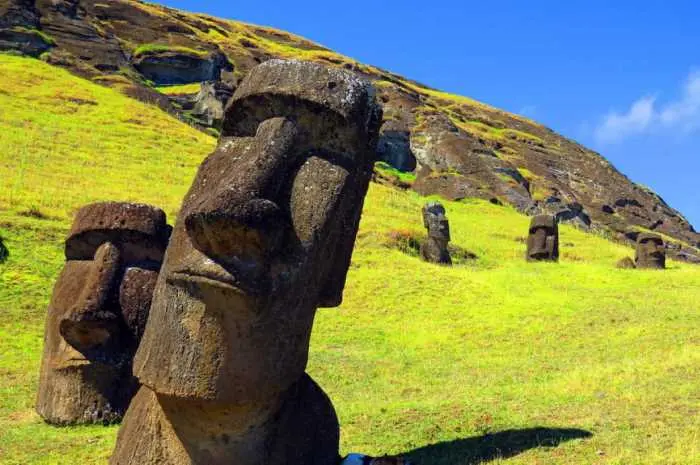Easter Island, known locally as Rapa Nui, is one of the most isolated inhabited islands in the world, located in the southeastern Pacific Ocean. Famous for its enigmatic moai statues, this tiny speck of land, a part of Chile, is steeped in history and mystery, attracting travelers from all corners of the globe.
This article explores the allure of Easter Island, diving into its history, culture, and the intriguing mysteries that shroud this remote paradise.
1. The Moai Mystique
Easter Island is synonymous with its colossal stone figures, known as moai. Created by the island’s early Rapa Nui inhabitants, these statues are awe-inspiring in their scale and craftsmanship. Carved from volcanic tuff, the largest of these giants stands at 10 meters tall and weighs over 75 tons.
The moai are believed to represent the spirits of ancestors, watching over the island. Their construction and transportation across the island remain one of the world’s great mysteries and a testament to the ingenuity of ancient Polynesian cultures.
2. A Rich Cultural Tapestry
The Rapa Nui people have a rich cultural heritage, with strong ties to their Polynesian roots. Their traditional music, dance, and art are integral parts of the island’s identity. The annual Tapati Rapa Nui festival is a cultural highlight, featuring competitions in ancient sports, traditional singing, and dancing, showcasing the vibrancy of the local culture.
3. A History of Environmental Catastrophe:
Easter Island’s history is a cautionary tale of environmental overexploitation. The island was once lush with palm forests, but deforestation, possibly for transporting the moai, led to ecological collapse.
This environmental disaster, combined with European contact in the 18th century, brought about drastic population decline and cultural upheaval, making the island a study subject for archaeologists and ecologists alike.
4. Exploring the Island’s Natural Beauty:
Beyond the moai, Easter Island boasts dramatic landscapes, from volcanic craters and lava formations to pristine beaches. The Rano Raraku quarry, where the moai were carved, is a must-visit site, as is the Rano Kau volcano with its breathtaking crater lake. Anakena Beach offers a tropical retreat with its white sands and swaying palm trees.
5. A Hub for Archaeological Research
Easter Island is a living laboratory for archaeologists and anthropologists. New research continually unveils more about the island’s past, from the way the moai were moved to insights into the Rapa Nui civilization’s societal structure and its eventual decline.
6. Sustainable Tourism
As tourism is a vital part of the island’s economy, there is an increasing focus on sustainable practices to preserve its unique environment and cultural heritage. Efforts are being made to balance visitor experiences with conservation, ensuring that Easter Island remains a marvel for future generations.
Conclusion
Easter Island is a destination unlike any other, a place where mystery, history and natural beauty meet. Easter Island is full of mysteries that have not yet been revealed, just like Socotra Island. Its remote location adds to its allure, offering an escape that is both physically and temporally distant from the modern world.
The island’s fascinating moai statues, rich cultural traditions, dramatic landscapes, and intriguing history make it a bucket-list destination for those seeking to unravel the mysteries of the past and experience the wonders of the Pacific.






